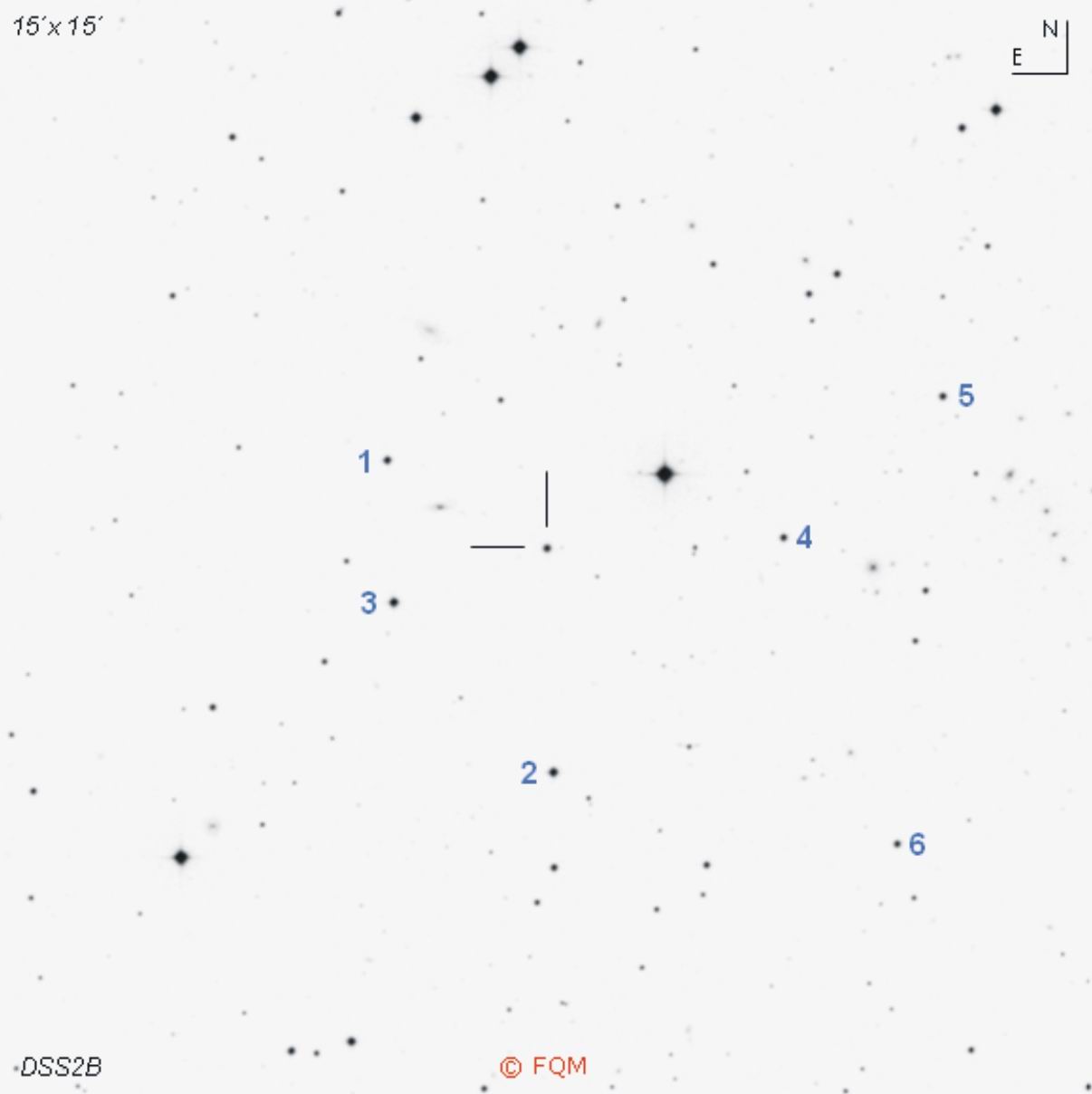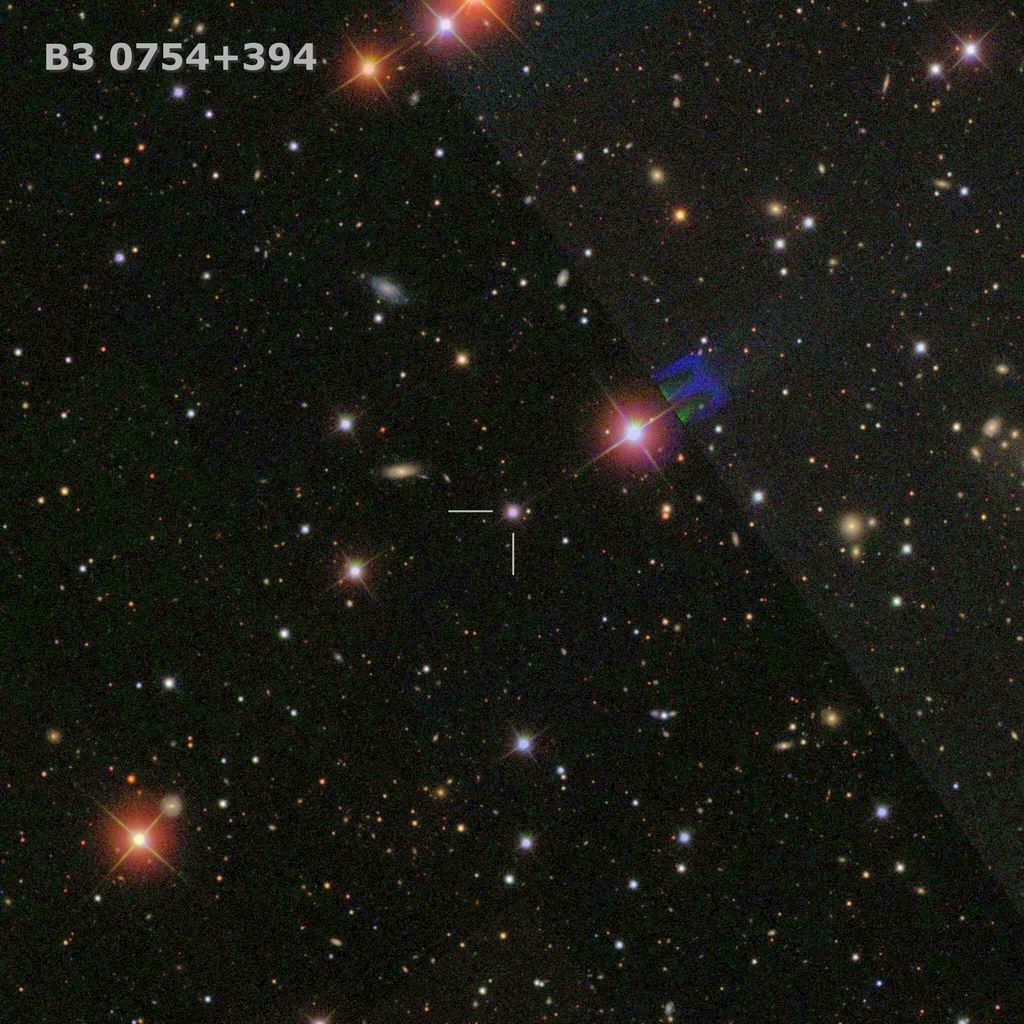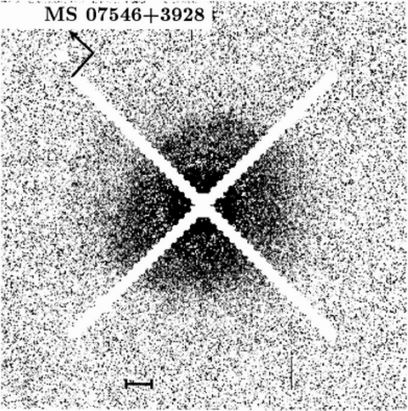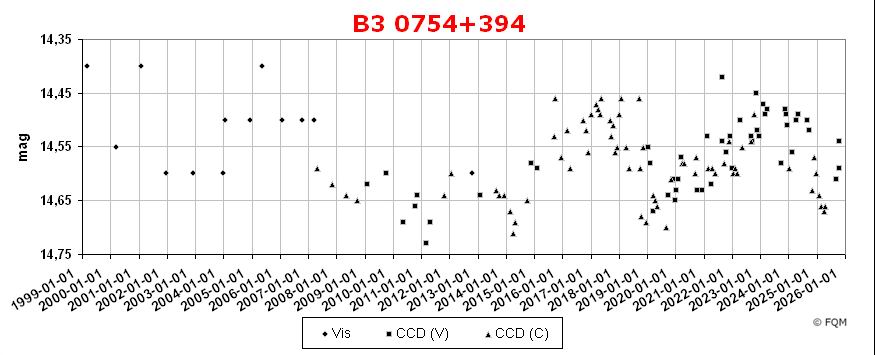
| Frankfurt Quasar Monitoring |
| B3 0754+394 |
| Cross-Identifications | LEDA 139042, IRAS F07546+3928, MS 0754.6+3928 FBQS J075800.0+392029, 1RXS J075759.7+392036 B3 0754+394, 1E 0754.6+3928, 2E 0754.6+3928 SDSS J075800.05+392029.0, QSO B0754+394 2MASS J0758000+392029, 0754+394 |
| Equat. coordinates | RA 07 58 00.1 DE +39 20 29 (J2000) |
| Constellation | Lynx |
| Type | QSO |
| Redshift (1) |
z=0.096 |
| Distance (2) (3) |
417 Mpc |
| Total mag range (mv) (4) (5) | 14.36 - 14.7 |
| Catalog Magnitude (1) | 14.36 |
| Absolute Magnitude (1) | -24.1 MB |
| Light Travel-Time (2) | 1.299 × 109 yrs |

Comparison stars
| star | B | V | Rc |
| 1 | 14.529 (0.013) | 13.799 (0.008) | 13.399 (0.009) |
| 2 | 13.752 (0.015) | 13.300 (0.009) | 13.031 (0.011) |
| 3 | 13.811 (0.014) | 13.001 (0.009) | 12.543 (0.010) |
| 4 | 14.920 (0.016) | 14.358 (0.010) | 14.032 (0.012) |
| 5 | 14.830 (0.017) | 14.269 (0.010) | 13.943 (0.011) |
| 6 | 14.999 (0.016) | 14.471 (0.011) | 14.157 (0.012) |




| B3 0754+394 is a radio-quiet quasar in southern
Lynx, about 8.8° NE of Castor (Alpha Gem). The designation B3
0754+394 refers to the 3rd Bologna Radio Catalogue (B3),
where this object was cataloged as a rather weak radio source. Initially,
B3 0754+394 was
discovered as an
X-ray source (1E). Follow-up spectroscopy led to the classification as
an AGN with Seyfert 1-spectrum.
High
resolution images revealed a host galaxy (LEDA) with a very bright
centre (QSO) and hints of spiral structure.
The SDSS image and
HST image (see
above) clearly show its extended optical appearance. In
addition, an apparent companion galaxy was found at a projected
separation of 9.5" (true distance 19 kpc), which may have triggered the
AGN
activity of
quasar B3
0754+394. The host galaxy of QSO B3 0754+394 is an outlying member of
galaxy cluster Abell 607, with its center located some 7arcmin W of the QSO
position. According to the CDS database both objects share the same
redshift. Some cluster galaxies can be seen in the charts above. B3 0754+394 is a small amplitude variable object with a total range of less than 1 magnitude. Observations by the Frankfurt Quasar Monitoring program have shown the quasar ranging only between mag 14.4-14.7. Therefore, this quasar is an easy task for visual observers with telescopes of 10-inch of aperture and larger. CCD observers, as well as visual observers, shall use the comparison stars given above. ____________
Another quasi-stellar object, quasar PG 0844+349, is a
bright 14-mag object at a distance of about 0.8×109
light-years,
11° ESE of quasar B3 0754+394. Only 4° to the east, another interesting deep sky object is waiting for observers: NGC 2419, dubbed the "Intergalactic Wanderer". NGC 2419 is a globular cluster which is located at the outskirts of the Milky Way galaxy, at a distance of about 300 000 light-years. A paper, published by Mackey et al. (2010), raised evidence that NGC 2419 is not a globular cluster, but the remnant of a dwarf galaxy, swallowed by the Milky Way. |
| Boyce, P.J., Disney, M.J., et al. 1998, MNRAS, 298, 121; HST Planetary Camera Images of Quasar Host Galaxies. Bowen, D.V., Osmer, S.J., Blades, J.C., et al. 1994, AJ, 107, 461; Hubble Space Telescope Faint Object Spectrograph QSO Absorption Snapshot Survey (ABSNA). Doroshenko, V.T., Sergeev, S.G., et al. 2005, Ap, 48, 156; BVRI CCD-Photometry of Comparison Stars in the Neighborhoods of Galaxies with Active Nuclei. I. Hansen, T. 1991, Deep Sky Magazine 34, 32; The "Deepest" Deep Sky Objects. Hutchings, J.B., Crampton, D., et al. 1984, ApJS, 55, 319; An Atlas of QSO Luminosity Profiles. Karge, S.; Helle Quasare für 8- bis 10-Zoll Teleskope. Ein Beobachtungsführer zur visuellen Beobachtung von Quasaren und BL Lacertae Objekten; Frankfurt 2005. Kriss, G.A., Canizares C.R. 1982, ApJ 261, 51; Optical and X-ray Properties of X-ray Selected Active Galactic Nuclei. Mackey, A.D., et al. 2010, MNRAS, 401, 533; Deep Gemini/GMOS Imaging of an extremely isolated Globular Cluster in the Local Group. Steinicke, W.; Katalog heller Quasare und BL Lacertae Objekte; Umkirch 1998. Steinicke, W.; Beobachtungsliste für helle Quasare; Umkirch 1999. Stephens, S.A. 1989, AJ, 97,10; Optical Spectroscopy of X-ray-selected Active Galactic Nuclei. Véron-Cetty, M.-P., Véron, P. 2001, A&A 374, 92; A Catalogue of Quasars and Active Nuclei: 10th edition. Véron-Cetty, M.-P., Véron, P. 2003, A&A 412, 399; A Catalogue of Quasars and Active Nuclei: 11th edition. Véron-Cetty, M.-P., Véron, P. 2006, A&A 455, 776; A Catalogue of Quasars and Active Nuclei: 12th edition. Véron-Cetty, M.-P., Véron, P. 2010, A&A 518, 10; A Catalogue of Quasars and Active Nuclei: 13th edition. |
| Links: ARAS (spectrum) Sterne und Weltraum 2-2015 (article, spectrum) Sloan Digital Sky Survey |
| home |